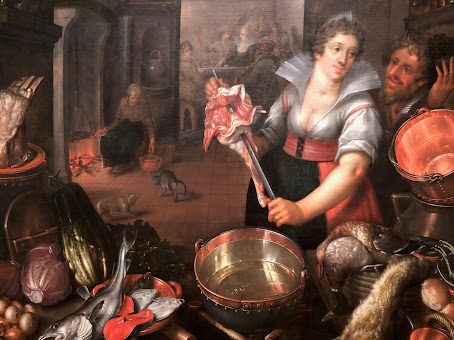Every object serves double duty: inventory and allegory. The dead duck, gutted fish, and marrow bone proclaim earthly abundance, prosperity’s Instagram flat-lay of 1600. But the lurking cats, half-hidden fire, and distant banquet whisper “memento mori.” Pleasure is fleeting, gluttony a moral landmine, and that rakish fellow eyeing the cook might be hunting more than dinner. The painting practically winks at you: Yes, revel in the sensory feast—but remember, tomorrow those oysters could kill you.
The Kitchen’s Poet Laureate
Born in Delft around 1570, Delff trained under his father, the portraitist Jacob Delff the Elder, before switching lanes to still life and genre scenes, where the real money (and fun) was. He refined an almost scientific interest in surfaces: the translucence of sliced onion skin, the greasy sheen of goose feathers, the matte bite of terracotta. Patrons loved the precision; moralists loved the sermons hidden beneath. In an age of Calvinist restraint, Delff offered a safe thrill: luxuriate in luxury while pretending you’re learning a lesson.
By the early 1600s, he’d carved out a niche as the Dutch Republic’s foremost kitchen dramatist, influencing Pieter Aertsen, Joachim Beuckelaer, and later Frans Snyders. His studio functioned less like an atelier and more like a proto-food-styling lab; rumor has it he kept aging carcasses on hand to study color shifts (and, presumably, to offend the neighbors). Though he died in relative obscurity in 1643, collectors revived interest in the 19th century, suddenly enthralled by the fidelity of his metalwork and the coy moral tension of his narratives.
Fat Times, Thin Souls
The Dutch Golden Age (roughly 1580-1670) was a period of significant economic growth, characterized by thriving trade, herring fishing, and a strong emphasis on hard-nosed Protestant ethics. Amsterdam bankers financed half of Europe, and even modest burghers could afford Chinese porcelain and Spanish citrus. Yet sermons thundered weekly about temperance, thrift, and the perils of Vanity Fair. Painters like Delff cashed in on the contradiction: depict opulence so vividly you can almost taste it, then slap on a subtle warning not to enjoy it too much.
Genre kitchens fit the bill perfectly. They showcased global luxuries delivered by the VOC (red mullet, Mediterranean artichokes) while remaining comfortably “domestic.” A well-stocked scullery meant both piety (order, diligence) and prosperity (profits, indulgence). Into this stew Delff stirred gender politics: a working woman wielding a cleaver signaled both empowerment and potential impropriety, depending on how sharply viewers’ pastors had scolded them that week.
Moral Side-Eye with Extra Garnish
Strip away the historical patina, and the Sumptuous Kitchen Interior still nails a 21st-century dilemma: achieving work-life balance in an always-on buffet line of temptation. Are we the focused cook, masterfully slicing through chaos? The ogling colleague, ready to poach someone else’s labor? Or the weary grandma, trapped at the metaphorical stove while management feasts in the boardroom? Delff suggests all three live in us simultaneously—passion, appetite, caution—each scrambling for control of the same mise-en-place.
And, let’s be honest, the painting also reminds us that PowerPoint slides, like raw poultry, spoil fast. Presentation matters: immaculate copper pots elevate a humble turnip into Instagram gold, just as a razor-sharp proposal narrative transforms boilerplate into award-winning capture strategy. Delff would have rocked capture management—he understood that stuffing the frame with salient detail only works if every cabbage leaf, each pewter bowl, argues a cohesive thesis.
If your own life’s kitchen were painted today, would viewers see disciplined mise-en-place, or a gluttonous free-for-all begging for a compliance audit?
#DutchGoldenAge #KitchenDrama #Pronkstilleven #ArtHistoryHumor #FoodForThought





No comments:
Post a Comment